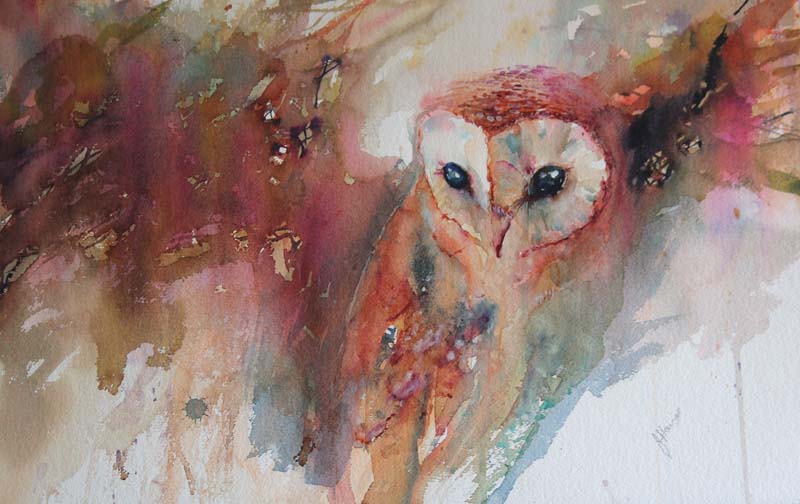Following on from the Jean Haines style snowdrops from last week, we were consolidating and extending what we learned from that, and applying that knowledge and techniques to painting these cockerels.
I decided that at this stage it would be easier to work from some of my own demonstrations than work from a photograph, as the object of this exercise was to get my students to use enough water for wet in wet pigment to blend it's self with the use of pigment flow, and this involved letting go of photographic accuracy and the kind of detail which it would be tempting to include when copying a photograph, however the limitations of working this way is to limit the student in following my own brush mark and colour choices.
This approach is very wet wash orientated.

Just like the snowdrops our first ( under ) wash, was there to represent the lighter areas which go under and beyond the darker areas you can see with hard edges.
So the cockerels head is the 1st light wash left to dry, and is defined by painting in the background around the head to define the edges of the head.
However I took my students too far too fast today, because if you can see the demonstration below left, the head is defined by a negative shape, and the beast feathers are painted in a positive shape, crossing over at the beak, and on the right hand side demonstration, the breast feathers are wet in wet to confuse matters more.
At this stage all I need my students to know, is that the background wash ( negative shape ) can define the main object if it is darker than the main object.

Below is the photo reference we are going to work on next week, but have a look at all the detail in this image, and imagine trying to resist painting each and every detail, I'm not saying it is wrong to do so, but a successful painting has a life of it's own, and is not just a slavish copy of a photograph, we bring something of ourselves to it, and when we edit out a lot of the detail from our reference material we are making decisions about what to leave out, and that choice is different for everybody.
Here are some student exercises done today with this technique and approach, please bear in mind that they are unfinished, and limited by copying my own demonstrations which were not carefully drawn or contained any finished detail, we will work towards that next week.
The student below is now using enough water with her pigment so that the pigments interacts with other pigments on it's travels down the paper and creates beautiful variations, not enough water results in the pigments staying put, which in this case will not result in watercolours self mixing.
This student maintained surface water consistency S W C until the end where the orange ran into dry blue, but in this case it enhances the painting as it's meant to be about texture, and subsequent washes can cover up these areas if necessary.
2nd washes are any hard edged areas within the main wash.
The student below used rock salt for the texture.
The student below is further exploring how to pull pigment out with a feathered brush to create a feather texture.
A half finished demo of mine

This is my demonstration below and above, ( unfinished ) demonstrating how to pull pigment out of the main wash to create feathers, the approach to adopt is keep it simple K I S

A cockerel with the eyes and beak painted in brings the whole painting together, please do this at home everybody, you can use the reference on the cockerel photo I have posted on here

Look at the lovely colours this student has created by allowing pigment flow, the surface of this painting was so wet it was pooling, no bad thing, easier to mop up a pool, than try to push paint around which can't move on it's own through too little water.

This student example below used the negative shape, ( background wash ) to define not only the cockerels head, but pulled this same wash out onto the paper on the other edge to create not only a lovely colour mix through pigment flow, but an interesting shape for the outer edge of this wash.
The 1st wash is everything you can see in peachy pink.

Please have another go at home everybody if you get time, use this approach, it's not easy, there are easier ways to paint in watercolour, but you don't learn as much or get the best results out of your work.
Below are some Jean Haines paintings which are good examples of creating a painting which you can see are far from photographic, notice not all her edges are defined, and she is more concerned with achieving her choice of colour mixes and texture than real life accuracy.
In short, she is, and we are learning to create a painting, and not just copy a photograph.







No comments:
Post a Comment